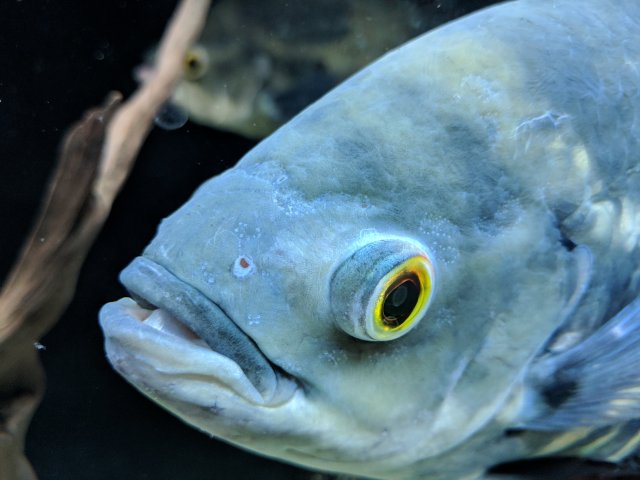Hi there!
I have a problem with my 3 years old oscar (another oscar and the others are OK): since November 2018 he has hole in the head disease, I already treated him 2 times without much of the success. My aquarium is 500 liters, 5 fishes 25-35 cm: 2 wild oscars, 1 petenia splendida, 1 jaguar, 1 pleco. I feed with different Hikari dry foods (cichlid gold, carnivore sticks, massivore delite). But mainly he eats Hikari Cichlid Gold. Water tests do not show anything bad, zero ammonia / nitrite, 30-40 of nitrates before the water change (5-10 of nitrate is in the tap water), I do 50% water change every week. Hardware is Eheim 1200XL, Fluval FX6, 500ml of fresh activated carbon constantly in the internal filter, small UV sterilizer. Temperature is 26 celsius degrees. The aquarium is 3 years old.
The story begins in November when my oscar rejected to eat and a day after he got 2 holes on his head. I immediately got ESHA HEXAMITA from a local pet store and did 2 sessions of treatment in the common tank. The guy started eating again shortly after starting the treatment, the holes started to cure, but the progress was extremely slow. In the beginning of February he again rejected to eat with one more hole. I didn't like ESHA medicine last time, because my other fishes reacted badly on it (especially petenia). This time I tried JBL SPIROHEXOL, did 2 treatment sessions (2 weeks). This time the holes cured better, he started to eat again, I did a water change 2 weeks ago, removed the medicine with activated carbon, and after another water change last Sunday he now again rejects to eat and gets one more small hole. So my questions are:
1) Is there anything wrong with my setup? I had some minor problems before, but I could perfectly handle it, it's the first time these 3 years I really have no idea what to do, nothing helps.
2) How should I treat him now? I could try pure metronidazole, but it's extremely hard to find without a prescription (I'm in Germany), I heard it helped many people in quite serious cases. But I would prefer some easier factory type medicine.
2) Should I treat him in the common tank? From my understanding it's a good idea and those medicines against hexamita don't harm the filtration much.
Thank you very much for your recommendations.

I have a problem with my 3 years old oscar (another oscar and the others are OK): since November 2018 he has hole in the head disease, I already treated him 2 times without much of the success. My aquarium is 500 liters, 5 fishes 25-35 cm: 2 wild oscars, 1 petenia splendida, 1 jaguar, 1 pleco. I feed with different Hikari dry foods (cichlid gold, carnivore sticks, massivore delite). But mainly he eats Hikari Cichlid Gold. Water tests do not show anything bad, zero ammonia / nitrite, 30-40 of nitrates before the water change (5-10 of nitrate is in the tap water), I do 50% water change every week. Hardware is Eheim 1200XL, Fluval FX6, 500ml of fresh activated carbon constantly in the internal filter, small UV sterilizer. Temperature is 26 celsius degrees. The aquarium is 3 years old.
The story begins in November when my oscar rejected to eat and a day after he got 2 holes on his head. I immediately got ESHA HEXAMITA from a local pet store and did 2 sessions of treatment in the common tank. The guy started eating again shortly after starting the treatment, the holes started to cure, but the progress was extremely slow. In the beginning of February he again rejected to eat with one more hole. I didn't like ESHA medicine last time, because my other fishes reacted badly on it (especially petenia). This time I tried JBL SPIROHEXOL, did 2 treatment sessions (2 weeks). This time the holes cured better, he started to eat again, I did a water change 2 weeks ago, removed the medicine with activated carbon, and after another water change last Sunday he now again rejects to eat and gets one more small hole. So my questions are:
1) Is there anything wrong with my setup? I had some minor problems before, but I could perfectly handle it, it's the first time these 3 years I really have no idea what to do, nothing helps.
2) How should I treat him now? I could try pure metronidazole, but it's extremely hard to find without a prescription (I'm in Germany), I heard it helped many people in quite serious cases. But I would prefer some easier factory type medicine.
2) Should I treat him in the common tank? From my understanding it's a good idea and those medicines against hexamita don't harm the filtration much.
Thank you very much for your recommendations.














